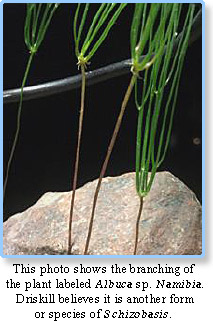Schizobasis (2015)
By Eric Driskill (June 2015)
 The monotypic genus Schizobasis intricata was changed to Drimia intricata in 2004. The genus Drimia has just over 60 species in South Africa and around 40 more species in other parts of Africa, Europe and Asia. And now it has one more in South Africa. So farewell, Schizobasis, but before you go, let us take one more look to connect a few dots before any name tags are changed.
The monotypic genus Schizobasis intricata was changed to Drimia intricata in 2004. The genus Drimia has just over 60 species in South Africa and around 40 more species in other parts of Africa, Europe and Asia. And now it has one more in South Africa. So farewell, Schizobasis, but before you go, let us take one more look to connect a few dots before any name tags are changed.
In the 1980s, Frank Horwood had an enormous three-headed specimen at Abbey Garden. Chuck Hanson of Arid Lands Greenhouse acquired that specimen, which proved to be sterile.
In the meantime, Hanson traveled to South Africa and collected seed of a form that proved to be self-fertile. This form was later offered as an International Succulent Introduction plant through the Huntington Botanical Garden in 2004.
At this time, nobody has one of these in their collection. The fact is, if you ever had one, you likely have dozens or hundreds of them by now. The plants flower freely and drop tiny black seeds the size of coarse crushed pepper.
With this form Hanson collected and introduced into cultivation, there may be millions in America. Hanson is a little bit like Johnny Appleseed.
Some years later, Chuck Hanson and Mike Massara discovered a new species of “Albuca” in Namibia. When Hanson auctioned off much of his personal collection, Mike Hellmann and I were fortunate enough to attend. While there, I asked about the curious little plant labeled Albuca sp. Namibia.
He told me he and Massara had found it in Namibia and were certain it was a new species. They had collected one specimen, at which I was looking right then. I asked if it was for sale, and Hanson said he wanted to get it to Massara.
A month later, I found myself in Ohio at Mike Massara’s house when others from Henry Shaw Cactus Society were visiting. I saw Hanson had sent the new Namibian albuca, and he recounted the same story Hanson had told me. Massara, however, agreed to sell it to me and assured me before I left that it was likely the only specimen in captivation.
I have had that plant now for many years, and it was divided several times. Over the years, I became convinced that it is much more like a schizobasis than any albuca I have ever seen.
Albucas produce a flower stalk separate from the leaves, whereas Schizobasis plants usually lack leaves. Many people mistake the flower stalk as a modified leaf.
The flower stalk on schizobasis emerges from the top of the depressed globose bulb as a tangle of wiry stems that resemble a failed cast of an open-faced reel. The bulbs often have three to five stems that emerge from the bulb and branch over and over, many terminating with a flower a little smaller than the end of a pencil eraser. Branching usually occurs at a 90-degree angle, and each new branch branches. Due to the angle of the branch on each flower stalk, it quickly becomes a tangled mess.
The plant I purchased as Albuca sp. Namibia has one stout stem per plant, and it branches much like S. intricata with the difference of angle. The place where it branches first usually has five to eight branches at the same spot. Each of those branch several times, but unlike S. intricata, even beyond the branching, the overall growth tendency is vertical.
 Similar to S. intricata, most of the branches terminate with a flower about the same size as those of Schizobasis. I have never seen any other growth (leaf). If, in fact, this is a new species of Schizobasis (Drimia), Chuck Hanson has doubled the number of species of that genus he brought into cultivation in America.
Similar to S. intricata, most of the branches terminate with a flower about the same size as those of Schizobasis. I have never seen any other growth (leaf). If, in fact, this is a new species of Schizobasis (Drimia), Chuck Hanson has doubled the number of species of that genus he brought into cultivation in America.
With the form of S. intricata being self-fertile, there are easily hundreds of thousands in collections across America. With this other species, there are still only five plants of which I know over 10 years of growth.
I have never obtained seed, but the bulb has split several times. Several years ago, I delivered the first new offset bulb to the Huntington Botanical Garden. Since then, the original plant has split again, and there are four stalks this year.
The bulbs of this plant are not nearly as spherical as those of S. intricata. These bulbs are more flat and come to a point at the top, are completely underground and are an incredibly spooky flesh color.
Both of these plants produce their flower stalks around February or March. They flower around early May and begin to turn yellow in late September. You can grow these bulbs with a certain level of neglect, treating them like most other cacti or succulents.
The plants do not grow quickly, and in many years, you will find you have dozens of them. And even after years, you may not ever see one outgrow the size of a small walnut.
